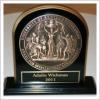By Kendall Smith
The UK College of Arts and Sciences Passport to the World program is taking a look at China, a country that continues to grow in global significance.
“It is one of the most important countries for America to develop better opportunities with economically, politically and socially,” said Keiko Tanaka, coordinator of the China Initiative.
Particularly over the the past 50 years, China has been one of the fastest growing countries in the world and has made its presence felt in the global arena and shows no signs of slowing down.
“We picked China because it is one of the most important countries for America to develop better opportunities with economically, politically and socially,” said Keiko Tanaka, coordinator of the China Initiative.
Particularly over the

















